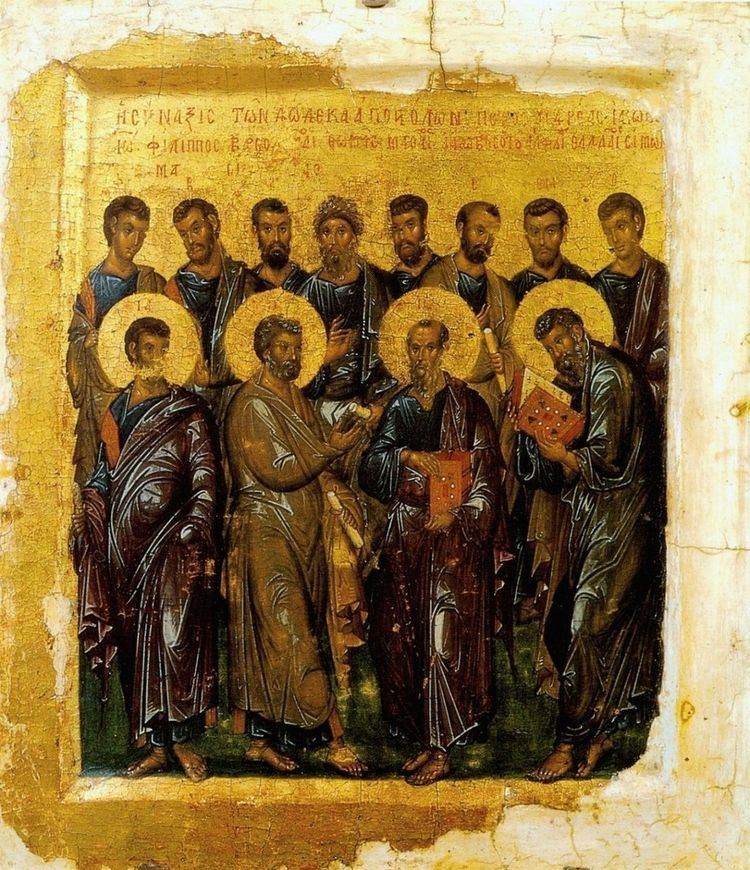 | ||
Matthew 10:1 is the first verse of the tenth chapter of the Gospel of Matthew in the New Testament. In this verse Jesus gathers his disciples and grants them healing powers in what is known as the commissioning the twelve apostles.
The original Koine Greek, according to Westcott and Hort, reads:
και προσκαλεσαμενος τους δωδεκα μαθητας αυτου εδωκεν αυτοις εξουσιαν πνευματωνακαθαρτων ωστε εκβαλλειν αυτα και θεραπευειν πασαν νοσον και πασαν μαλακιανIn the King James Version of the Bible it is translated as:
And when he had called unto him his twelve disciples, he gave them power against uncleanspirits, to cast them out, and to heal all manner of sickness and all manner of disease.The modern World English Bible translates the passage as:
He called to himself his twelve disciples, and gave them authority over uncleanspirits, to cast them out, and to heal every disease and every sickness.For a collection of other versions see BibRef Matthew 10:1
Following the accepted theory of Markan priority, this verse is a reworking of parts of Mark 3:13-15, which describes the gathering of the twelve, and Mark 6:7, which describes Jesus giving them authority over unclean spirits.. Matthew drops the mention of the meeting of the disciples taking place upon a mountain, as Matthew has already used that passage to set the location of the Sermon on the Mount at Matthew 5:1. Schweizer considers this verse a somewhat awkward insertion of Markan material into Matthew's narrative. It seems to contradict what is implied at 9:38. Matthew also jumps immediately to their being twelve disciples. Previously Matthew 4 had mentioned the recruitment of the four fishers, and Matthew 9 introduces Matthew the tax collector, but there is nothing in the text introducing the other seven. This same material also appears at Luke 6:12-13 and Luke 9:1.
Matthew also introduces the group of twelve later in his narrative than the other gospel writers. He had earlier mentioned the collection of disciples at a number of points earlier, but had left their number undefined. Other parts of the New Testament, such as Mark 3:16 and 1 Corinthians 15:5 make clear that Jesus had more than only twelve followers, and that this group of twelve are the leaders of the organization.
The different gospels have different lists of the names of the disciples, but one fact they are agreed upon is that there were twelve. This could be evidence for the historicity of their being twelve original followers of Jesus. The number twelve also had deep social and religious significance. The number creates a metaphorical link to the Twelve Tribes of Israel. At the time most Jewish leaders believed that the messiah would bring about an eschatological restoration of the tribes. This link is made explicit at Matthew 19:28. The Qumran community, which produced the Dead Sea Scrolls, also had a group of twelve leaders, perhaps for similar reasons. In the culture of the time a group of twelve indicated a complete set, and readers would thus consider a number slightly below or above twelve to be odd.
Jesus gives the disciples powers to heal. The ability of one miracle worker to train others is found in the Old Testament as well, such as the education of the Elisha by Elijah. The Greek makes clear that healing illnesses and casting out spirits were two parts of the same act, a reflection of the common belief at the time that diseases were caused by demonic possession. Throughout the New Testament the power to conduct such exorcisms is one of the leading examples of spiritual power.
